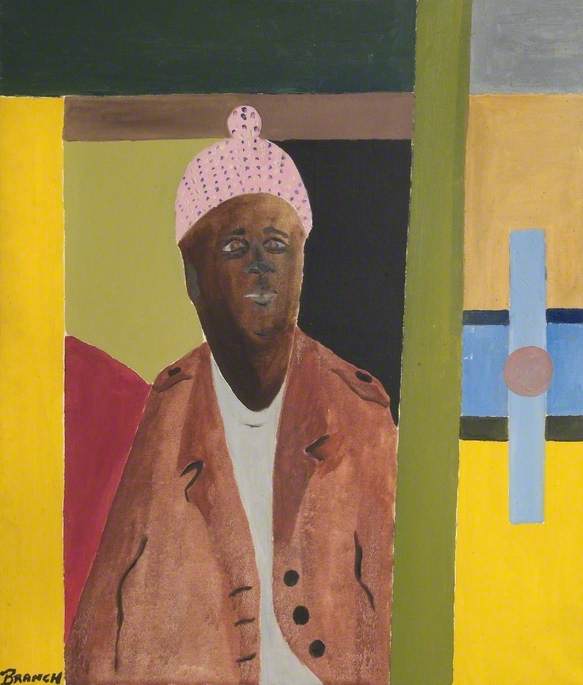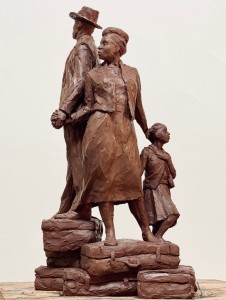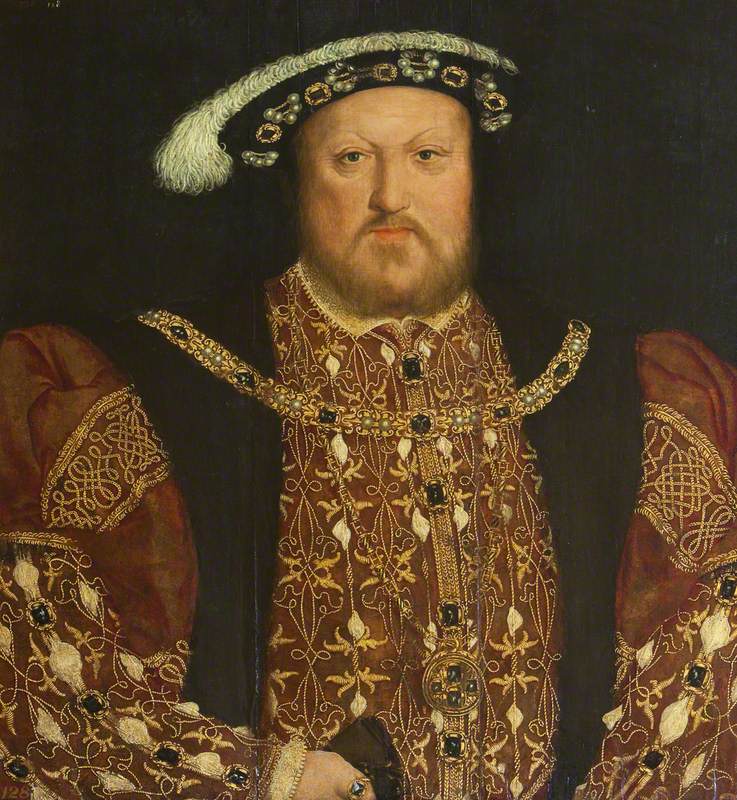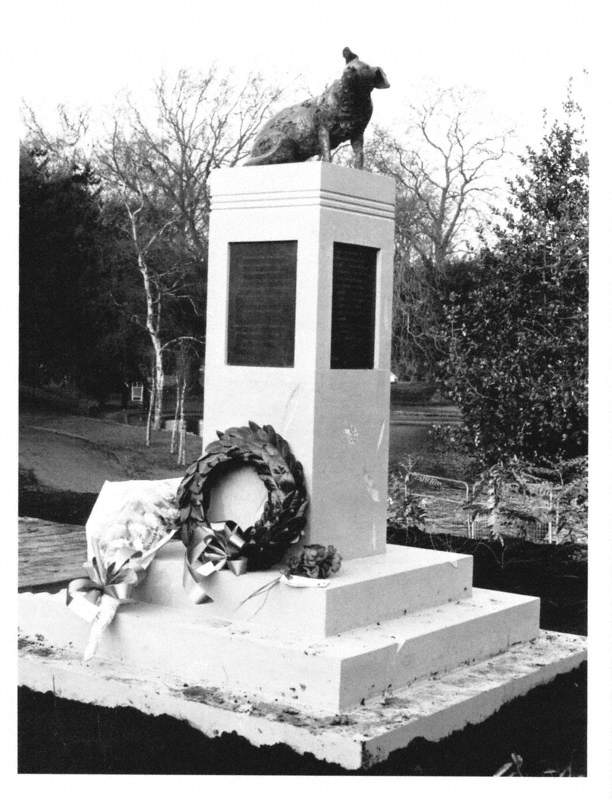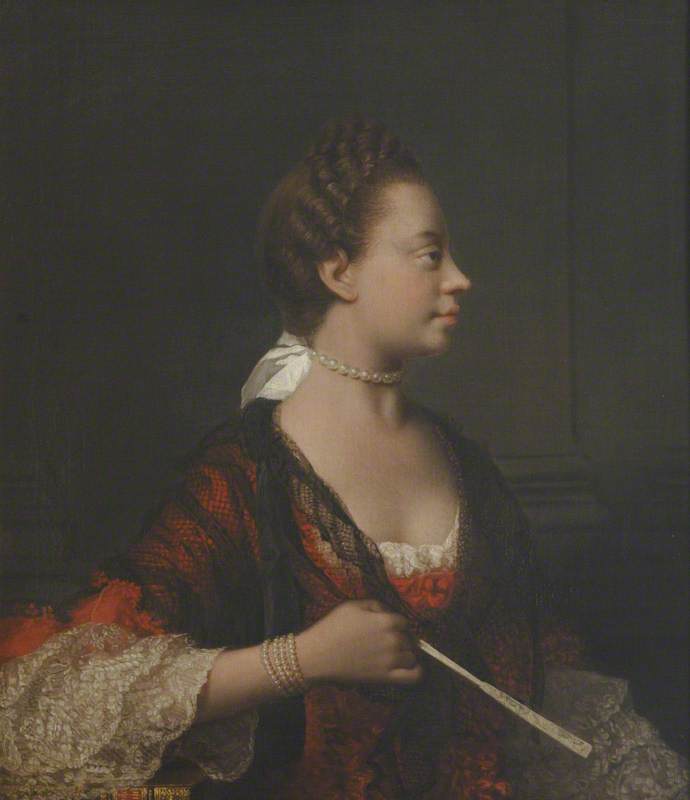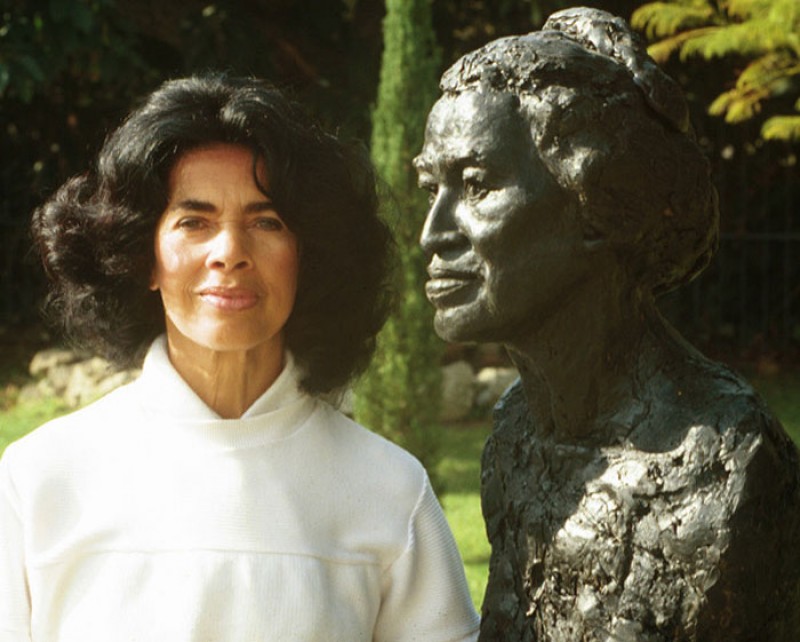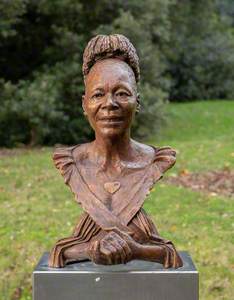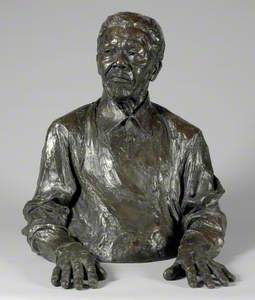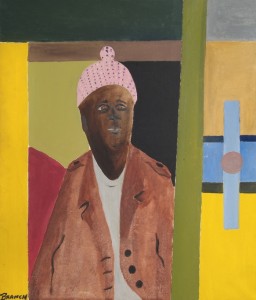Art UK has previously asked 'where are the people of colour in the nation's oil paintings?' – taking a look not just at Black subjects, but a range of sitters of colour. Even up until the twentieth century, often when these figures were included in paintings, they were done so with a large measure of Orientalism, colonialism or simply racism.
Turning to sculpture, there are hundreds of named white men (and women) on pedestals in public places, and in collections. As a counterpoint, here are ten Black subjects who have been memorialised, lionised or commemorated in sculpture.
1. Floella Benjamin
Anyone growing up in the UK in the 1970s and 1980s will surely have grown up with the wonderful Floella Benjamin on Play School and Play Away – she was perhaps the most widely recognised Black person on TV for kids at the time. Born in Trinidad, she came to England in 1960, settling in Beckenham.
Since her heyday with the round window, she has continued to inspire people throughout her career as a presenter, actress, author and businesswoman. She was awarded an OBE in 2001 and in 2010 she was created a life peer (she was created Baroness Benjamin of Beckenham) – she sits in the House of Lords as a Liberal Democrat. She was appointed a Dame (DBE) in 2020 for services to charity.
This bronze bust is still one of very few public sculptures of a named living Black woman in the UK. It was commissioned for Exeter University, where Benjamin was Chancellor from 2006 to 2016.
2. Alfred Fagon
Alfred Fagon was an actor, playwright and poet whose works were widely performed in the 1970s and 1980s, including at the Royal Court Theatre and Hampstead Theatre. He was born in Jamaica in 1937 and migrated to Britain in 1955, working for National Rail and then the army. After leaving the army in 1963 he moved to Bristol, and lived in the St Paul's area during the 1960s and 1970s.
This bronze bust was commissioned by the Friends of Fagon committee on the first anniversary of his death, in 1987. The location was chosen because Fagon would often say 'the heart of St Paul's is at the corner of Ashley Road and Grosvenor Road' – which is near to where he lived.
The annual Alfred Fagon Award has been awarded since 1997 for the best new play by a Black British playwright of Caribbean or African descent, resident in the UK.
3. Learie Constantine
Learie Constantine was born in Trinidad in 1901, and his grandparents had been enslaved. He first found fame in the 1920s as a cricketer for the West Indies, and was known as possibly the finest fielder in the history of the game. His performance at Lord's led to a contract to play for Nelson, Lancashire.
In 1944 he won a historic court case against the Imperial Court Hotel for 'failing to receive and lodge' him on grounds of colour. His post-cricket life was also eventful – he was called to the bar in 1954 and returned to Trinidad, where he became an MP and a minister.
He became High Commissioner for Trinidad and Tobago, returning to London, and then became the first black peer in 1969. He was also a governor of the BBC, Rector of St Andrew's University, and a member of the Race Relations Board.
This sculpture is by Karin Jonzen, a sculptor and teacher, born in London of Swedish parents. Her other portraits include Paul Scofield, Max von Sydow and Malcolm Muggeridge.
4. Olaudah Equiano
Although this sculpture is of the eighteenth-century figure Olaudah Equiano, it was only made in the twenty-first century. Equiano was one of the most celebrated Black figures in Georgian Britain. In 1789 he wrote an account of his time as an enslaved African, and this was an important testimony in the continuing fight for the abolition of the Slave Trade (and eventually slavery itself).
OLAUDAH EQUIANO – African, slave, author, abolitionist
2006
Christy Symington 
Born around 1745 in West Africa, Equiano was 11 years old when he was kidnapped, enslaved and transported to the West Indies, and subsequently to West Virginia and England. He was baptised in Westminster in 1759 but in 1766 he 'bought his freedom' and was recognised as a free man. He travelled extensively, before settling in Britain in the 1780s, marrying an English woman – they were survived by a daughter, Joanna Vassa.
His autobiography both captivated and shocked British audiences. Equiano attended debates in the House of Commons on slavery and the abolition of the slave trade in 1788 and addressed the government directly through published letters. He toured England, Scotland and Ireland, selling copies of his book and speaking on his life and the abolitionist cause. He died in 1797, ten years before the transatlantic slave trade was abolished.
OLAUDAH EQUIANO – African, slave, author, abolitionist
2017
Christy Symington 
Sculptor Christy Symington created this likeness based on portraits thought to be Equiano. There are versions in the International Slavery Museum, Liverpool, the Royal Museums Greenwich and the Parliamentary Art Collection.
5. Walter Tull
This full-size statue in Northampton depicts Walter Tull (1883–1918) – the second Black professional player in the Football League. He played for Northampton Town as well as Tottenham Hotspur.
Tull was born in Folkestone, Kent, to an English mother and a Barbadian father. He played for Spurs between 1909 and 1911, and then made 105 appearances for Northampton Town, scoring nine goals.
In 1914, at the start of the First World War, he joined the Football Battalion where he was promoted to sergeant and became the first black officer in the British army. He was killed in action on 25th March 1918.
Richard Austin's sculpture of Tull in his football kit and boots was installed outside the Northampton Guildhall in 2017.
Although Tull was the second professional Black footballer, the first was Arthur Wharton. There is a sculpture on Art UK commemorating him too, although it is less of a bust and more of a plaque.
It features Wharton's head surrounded by symbols representing his life and the clubs he played for, including a Scottish thistle, Ghanaian black stars, Grenadian nutmeg, and an English rose. There are references to Preston, Newcastle and Sheffield, where he played, and on his chest is the Darlington Football Club crest, where he played in goal for three seasons from 1885.
6. Jackie Kay
Born in 1961 to a Scottish mother and a Nigerian father, Jackie Kay explored her own situation as the adopted child of white Scottish parents in her first collection of poems, The Adoption Papers (1991). She has since published more collections, the novel Trumpet (1998), plays and short stories.
In 2016 she became Scots Makar, the national poet laureate.
This bust is one of a series of 12 portrait busts of Scottish poets sited along the pathway of Lochside Crescent in Edinburgh.
7. Paul Robeson
Paul Robeson (1898–1976) was an American singer, actor, and civil rights campaigner. He campaigned against segregation and lynching in America, and he also fought for better pay and conditions for the Welsh miners in the Rhondda Valley during the 1930s. His left-wing politics, combined with the colour of his skin, meant he was seen as a threat by the 1950s American establishment, and during the McCarthy era he was blacklisted on suspicion of being a Communist.
There are a few sculptures of him in UK collections: two by Jacob Epstein in Touchstones Rochdale and York Art Gallery, and one by Ronald Moody in Amgueddfa Cymru – National Museum Wales.
He performed extensively in the UK, particularly in Show Boat (in which he famously sang Ol' Man River, both on stage and the 1936 film), and was the first Black actor to portray Othello in Britain since Ira Aldridge, when he acted opposite Peggy Ashcroft in 1930.
Robeson returned to the United States in 1940, but a measure of his enduring fame and popularity in this country can be seen in an incident from 1957 when he still was banned from leaving the US due to being blacklisted. He sang for audiences in London and Wales via a transatlantic telephone cable – 1,000 concert tickets for the telephone concert at St Pancras Town Hall sold out within an hour.
8. Erinma Bell
Dr Erinma Bell is a peace activist recognised for her work tackling gun crime in Moss Side and Longsight in Manchester.
Erinma and her husband Raymond witnessed a close friend being gunned down in front of them. They set up CARISMA (Community Alliance for Renewal, Inner South Manchester Area) to give young people positive alternatives to street and gun crime.
The bust was produced as part of the 'Guns to Goodness' project to put confiscated guns to good use, and was the first sculpture of a woman to be placed in Manchester Town Hall.
9. Nelson Mandela
Nelson Mandela was the first Black President of South Africa, in power from 1994 to 1999. This sculpture is in the Parliamentary Art Collection and dates to 1996, made during his presidency, when he sat for the sculptor John Doubleday. There are editions of the same sculpture in South Africa and in other places around the world.
From 1964 to 1990, Mandela was imprisoned for his involvement in the armed resistance to South Africa's apartheid regime. He became an international symbol of freedom, social justice and racial equality.
His presidency saw the reconciliation of black and white South Africans, for which he was awarded the Nobel Peace Prize (with F. W. de Klerk) in 1993.
This sculpture in the National Portrait Gallery is by Ian Walters, based on a work from 2001.
Nelson Mandela (1918–2013)
(based on a work from 2001) 2008
Ian Homer Walters (1930–2006) 
Walters had created another bust of Mandela back in the mid-1980s, which was installed on the South Bank by the Greater London Council. He is also the sculptor of the Mandela statue in Parliament Square, although it was only unveiled in 2007, after Walters had died from cancer.
10. Jimi Hendrix
Widely acknowledged as one of the greatest guitarists of all time, you might wonder what a sculpture of Jimi Hendrix is doing on the Isle of Wight.
In fact, although he was American, Hendrix established his career in the UK before crossing back over to the States. The Handel-Hendrix House in London is now a museum to where he lived, just next door to (and around two hundred years after) Handel.
After his era-defining sets at the Monterey Pop Festival (1967) – where he set fire to his guitar – and Woodstock (1969) – where he closed the festival with an incendiary rendition of the US national anthem – he started work on new material with a new band.
On 31st August 1970 he played the Isle of Wight Festival – hence the sculpture, where he's dressed as he was during the performance, with his trademark Fender Stratocaster (right-handed, but played upside down as he was left-handed).
Hendrix was to die from an overdose just a few weeks later, robbing the world of his mercurial talent.
Although there are relatively few Black subjects celebrated in sculpture, the number is growing, and through Art UK's sculpture project we are able to see how quickly the landscape is changing.
Most of these artworks are very recent, and show perhaps a desire by artists and the public to combat the lack of celebration around Black achievement.
Andrew Shore, Head of Content at Art UK





